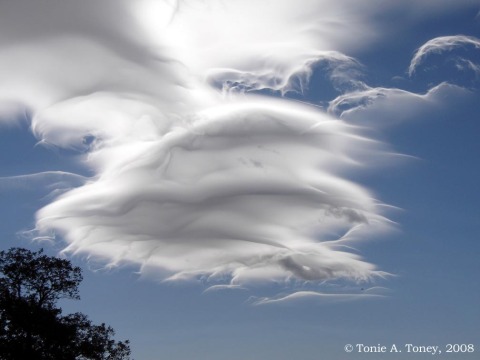ALTOCUMULUS LENTICULARIS
A single left click followed by another single left click will enlarge this image significantly.
Altocumulus lenticularis clouds are not rare but, none-the-less, they inspire countless observers and much “camera clicking” occurs when they are present. Forming mostly over mountainous topography, they generally mark the movement of the air at the altitude where they form. Often (as in this case) they form not immediately above the mountain peak (or peaks) themselves but quite some distance higher. In this case it is forming on a “lee wave.” Rising air is what causes most clouds to develop and this is no exception. Envision water flowing quickly in a stream over a boulder that is on the bottom. Not only does the water touching the boulder rise up and over – so does the water above that lowest layer; and if you look closely you might see at least one other standing wave on the downstream side of the boulder. Likewise, a prevailing wind obstructed by a mountain or mountain range is forced to rise up and over and the air above it does the same. If the air aloft contains enough moisture and the lifting cause enough cooling of that air, condensation (and deposition) can occur forming cloud droplets and ice crystals respectively.
I took this photo today (10-29-2008) from the Blue Ridge Parkway. The clouds are forming on the leeward side of the Black Mountain Range, the famous range most notable for the highest peak in the U.S.A. east of the Mississippi, Mt. Mitchell. I was northeast of Mt. Mitchell at the first viewpoint northeast of the intersection of the Parkway with highway 80. The camera faced south-southeast.
The environment was changing quickly while I took several photos. I intend to post more soon in order to demonstrate how quickly the changes were occurring (which was a function of how rapidly the air was moving up there).
In this region the prevailing winds aloft are from west to east (generally speaking) and the Black Mountains trend north-south. The Black Mt. Crest Trail, rated “difficult” runs northward from the top of Mt. Mitchell (which can be reached by roadway) for about 7 miles to Celo Knob. From near the top of Celo Knob the Bowens Creek Trail heads northwestward another 5 miles to the mountain valley below. My youngest daughter hiked the trail with me when she was 11. It was an experience I’ll never forget – nor will she.


Breathtaking….I’ve never seen clouds this beautiful. No wonder you love them so much.
We dont get them over here…..o I have never seen them.
Terry